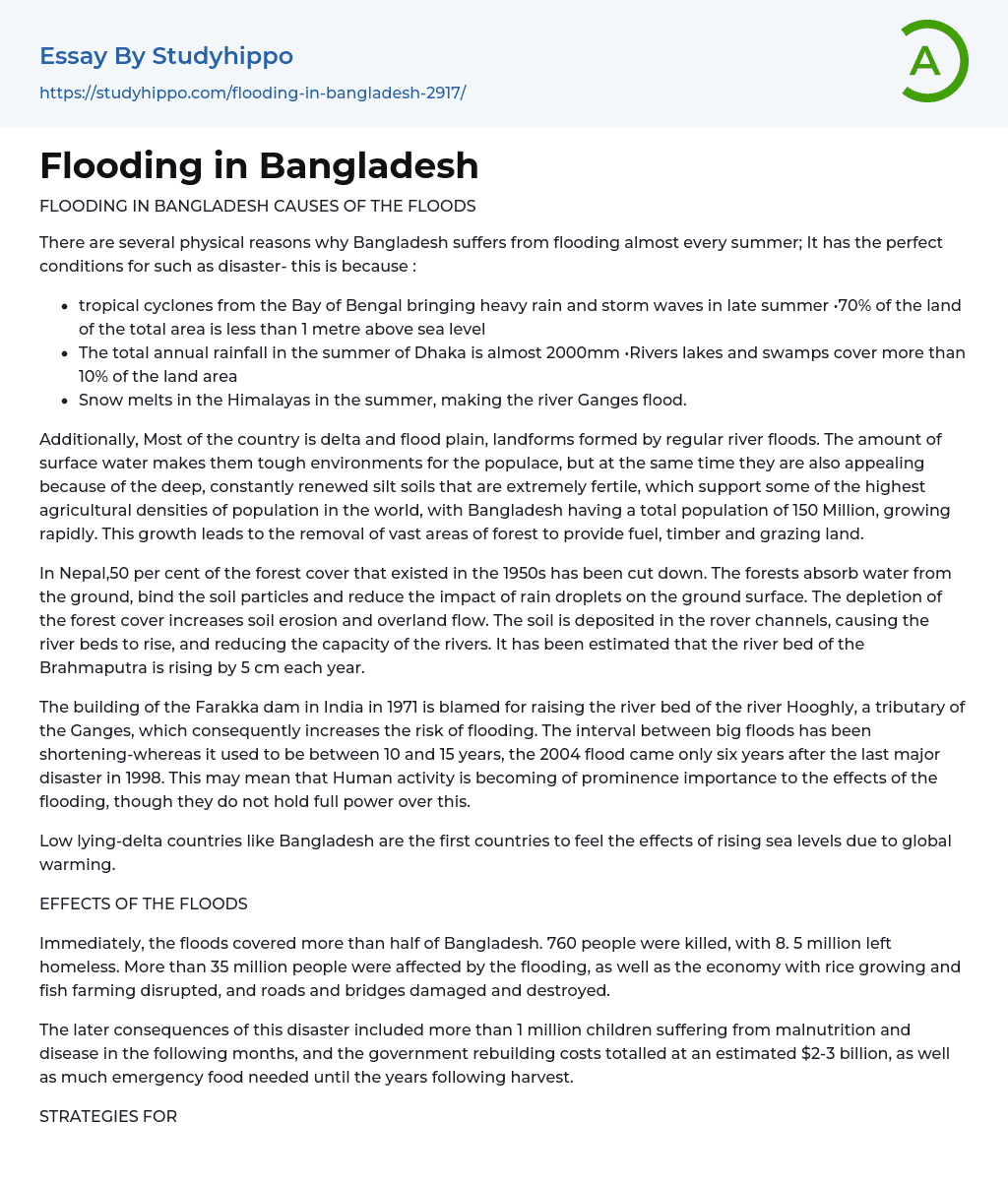Flooding In Bangladesh Causes Of The Floods
There are several physical reasons why Bangladesh suffers from flooding almost every summer; It has the perfect conditions for such as disaster- this is because :
- tropical cyclones from the Bay of Bengal bringing heavy rain and storm waves in late summer •70% of the land of the total area is less than 1 metre above sea level
- The total annual rainfall in the summer of Dhaka is almost 2000mm •Rivers lakes and swamps cover more than 10% of the land area
- Snow melts in the Himalayas in the summer, making the river Ganges flood.
Additionally, Most of the country is delta and flood plain, landforms formed by regular river floods. The amount of surface water makes them tough environments for the populace, but at the same time the
...y are also appealing because of the deep, constantly renewed silt soils that are extremely fertile, which support some of the highest agricultural densities of population in the world, with Bangladesh having a total population of 150 Million, growing rapidly. This growth leads to the removal of vast areas of forest to provide fuel, timber and grazing land.
In Nepal,50 per cent of the forest cover that existed in the 1950s has been cut down. The forests absorb water from the ground, bind the soil particles and reduce the impact of rain droplets on the ground surface. The depletion of the forest cover increases soil erosion and overland flow. The soil is deposited in the rover channels, causing the river beds to rise, and reducing the capacity of the rivers. It has been estimated that the river bed of the Brahmaputra is rising
by 5 cm each year.
The building of the Farakka dam in India in 1971 is blamed for raising the river bed of the river Hooghly, a tributary of the Ganges, which consequently increases the risk of flooding. The interval between big floods has been shortening-whereas it used to be between 10 and 15 years, the 2004 flood came only six years after the last major disaster in 1998. This may mean that Human activity is becoming of prominence importance to the effects of the flooding, though they do not hold full power over this. Low lying-delta countries like Bangladesh are the first countries to feel the effects of rising sea levels due to global warming.
Effects Of The Floods
Immediately, the floods covered more than half of Bangladesh. 760 people were killed, with 8. 5 million left homeless. More than 35 million people were affected by the flooding, as well as the economy with rice growing and fish farming disrupted, and roads and bridges damaged and destroyed.
The later consequences of this disaster included more than 1 million children suffering from malnutrition and disease in the following months, and the government rebuilding costs totalled at an estimated $2-3 billion, as well as much emergency food needed until the years following harvest.
Strategies For Managing Floods
The short term prime concern with managing a disaster in such a poor country as Bangladesh is always dealing with the health, survival, and suffering of the people affected.
Heavy reliance is placed upon emergency aid(food, drinkable water, medicines, plastic sheets, boats for rescue) from international organizations such as the united nations, governments of rich countries, and charities. One of the main problems is distribution, because
so much of the country is underwater, though as they recede it becomes easier to set up medical treatment centres, distribute water purification tablets and provide help with repairing houses and restarting economic activities, such as farming and fishing.
However, these actions do not much help to manage the flood problem in the long term. In July 1987 the World Bank prepared an action plan for flood control. A ‘hard engineering’ approach to flood management. The plan involved the completion of 35000 kilometres of coastal and river embankments and included seven large dams- partly to stop water from reaching the land and partly to provide up to 15 floodwater storage basins. Millions of dollars of aid were poured into these engineering projects, but the scheme remains unfinished due to a mixture of corruption and inadequate funding.
From the beginning, some people suggested that what Bangladesh really needed was a mixture of strategies involving flood forecasting and early warning schemes and more flood shelters stocked with emergency supplies on the other. It’s arguable that these would be more appropriate and cheaper for fishing communities in rural areas, as they would less likely damage delicate ecosystems, therefore making a contribution to the sustainable development of Bangladesh.
- Stream essays
- Bangladesh essays
- China essays
- Hong Kong essays
- India essays
- Japan essays
- Kuala Lumpur essays
- Malaysia essays
- Manila essays
- Pakistan essays
- Philippines essays
- Singapore essays
- Vietnam essays
- Vietnamese essays
- Air Pollution essays
- Carbon Dioxide essays
- Climate essays
- Deforestation essays
- Ecology essays
- Endangered Species essays
- Environmental Issues essays
- Environmental Protection essays
- flood essays
- Greenhouse Gas essays
- Hurricane essays
- Nature essays
- Pollution essays
- Renewable Energy essays
- Sustainability essays
- Tornado essays
- Traffic essays
- Tsunami essays
- Water Pollution essays
- Atmosphere essays
- Biodiversity essays
- Coral Reef essays
- Desert essays
- Earth essays
- Ecosystem essays
- Forest essays
- Lake essays
- Natural Environment essays
- Ocean essays
- Oxygen essays
- Rainbow essays
- Sea essays
- Soil essays
- Volcano essays
- Water essays
- Wind essays




